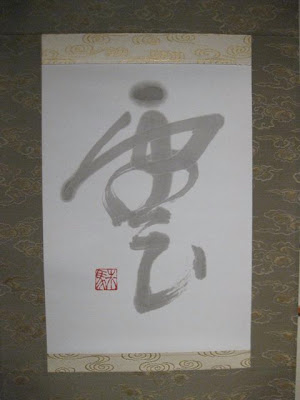Judy said that was part of the art of calligraphy. The art should express the mood what is written.*
But in this one I can actually find some. If you look at the second row, left column of the Chinese characters in the description, you can see ⽕ (fire) and ㆔ (three) and ⽉ (moon or month). They are in the middle column of the calligraphy. Find the ㆔. The ⽉ is below it. The ⽕ is up two from it.
And you should be able to 'find them' in the English translation.
I can see a violet flower in the image of this character. (I hope it's the right one.)
 | ||||||
| Clouds - Christine Schulbach |
As I understood it, the calligraphers were guided by Fujii Sensei who led a workshop. The website of the calligraphy organization - meitokai - has a brief bio:
"Master Calligrapher Yoshiyasu Fujii (b. 1963, Fukuoka, Japan) began calligraphy studies at the age of five, in his childhood home of Saga, Japan. He attended Daito Bunka University and studied under Master Calligrapher Shumpo Akashi, with whom he would continue to study until Akashi’s death in 1995. While studying with Akashi, Fujii studied sumie painting and pursued his interest in the history, not only of Japanese calligraphy, but of Chinese classical calligraphy in addition to all of the traditional calligraphy writing styles. Fujii is the recipient of many honors, including top award at Mainichi Calligraphy Competition, Japan’s oldest, largest, and most prestigious calligraphy competition, in 1990 and 1992. He has served as assistant judge at the Mainichi Calligraphy Competition and is the only calligraphy instructor in the U.S. licensed by the Japanese Ministry of Education."

He talked to us a bit about the exhibit and the calligraphy on the floor which he had done the other day in a demonstration. He's put some pictures of this exhibit on his website too.
The card with this calligraphy offers a haiku:
"Leaving Japan. Just as the Persimmons finally ripen.
(A Haiku by Judy's Mother)"
Judy told us that her mother wrote haiku for over 50 years and they have all been published. Judy is, I believe she said, an artist rather than a calligrapher. So her calligraphy reflects that artist's eye.

We got there not too long before closing - and watched them take photos before taking down the exhibit.
It seems I got a picture (not sharp enough to post though) of one card, but I seem to have forgotten to get the scroll with it. It's one of Fujii Sensei's work:
A person can claim to drink the first cup of liquor. But by the third cup, it's the liquor that swallows the person. I can't recall who said this to me, but I wrote it on my waist band as a warning.I thought it a profoundly simple and universal truth.
*A website called Beyond Calligraphy has this on the deeper meaning of calligraphy:
The Art of Far Eastern (mainly Chinese and Japanese) calligraphy is a universe on its own, sewed with passion, soaked in love, painted in stunning beauty, sparked by raw emotions, and secluded under a translucent veil of ancient mystery. We find it as fascinating as the miracle of life itself. Our intention at beyondcalligraphy.com is to reveal and share secrets of this vast world by bringing it straight to your home.
I'm not sure how much Japanese calligraphy I've seen. Mostly I've seen Chinese work. For those unfamiliar with Japanese writing, they use a combination of Chinese characters - Kanji - and two phonetic alphabets. One is for native Japanese words and the other for words borrowed from other languages and scientific terms. You can learn much more at linguanaut.The art of writing Chinese characters is often misunderstood for many reasons. One is that not many people realise that in calligraphy, kanji (漢字, i.e. Chinese characters) are to be felt long before they are being read. Another is that the word “calligraphy” in western understanding means nothing more than a craft of writing in a beautiful manner, whereas here in the East we refer to it as “way of writing” (Japanese: 書道, shodou) or “laws of writing” (Chinese: 書法, shufa), which is to be understood as a “chosen life path”, a sacred knowledge, far beyond the definition of “art”.


No comments:
Post a Comment
Comments will be reviewed, not for content (except ads), but for style. Comments with personal insults, rambling tirades, and significant repetition will be deleted. Ads disguised as comments, unless closely related to the post and of value to readers (my call) will be deleted. Click here to learn to put links in your comment.